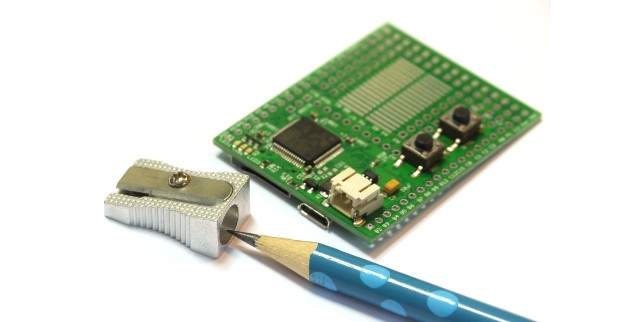Way back when, one of my friends in high school was a guy named Dave Wilson whose father got him into Moog-style analog electronic music synthesizers. Dave created a museum of historical synthesizers in his home in Nashua, New Hampshire. Through my high school and college years, we exchanged ideas and circuits and bits of lore for various synthesizer hacks. These synthesizer modules were implementing mathematical functions that could be implemented in digital electronics. So we both at various points and in various contexts wrote code to do that.
The Tooba is going to be some of that built into a short length of 3" PVC tubing. There will be a two or three-octave touch sensitive keyboard and some linear slide pots for various synth parameters. Sound will be generated in the same Teensy 3.1 controller board that scans the keyboard. Unless the poor little CPU gets overwhelmed, then maybe I'll put in a second Teensy for sound generation.
Here is a prototype, mostly testing the touch-sensitive keyboard. For this version the sound was generated by Timidity running on a Raspberry Pi, and the form factor is obviously different. The keyboard misbehaved in this video because of a sagging under-powered 12-volt supply.
UPDATE: Wrong! The keyboard misbehaved because of a programming error identified much later, now corrected.
I'll add more to this post as the thing gets closer to completion.
I had some confusion about the date for the Rhode Island Mini Maker Faire (last year it was a month after the NYC Maker Faire) so I had to hustle when I got the date correct. But I managed to pull it off and have got the thing working.
I also had to figure out how to mount the copper hexagons on the PVC tubing. Eventually my technique got good enough, but by then I had a mix of well-soldered and poorly-soldered hexagons, and the latter periodically pop off. So in the video below you'll see some missing hexagons that I need to replace before I head down to Providence.
So that's the gadget. There is a lot of clean-up to do on the mechanical design. Now I feel it's stable enough to justify laying out a printed circuit board. And the inside wires should be replaced by ribbon cable. But hey, it's working.
The Tooba is going to be some of that built into a short length of 3" PVC tubing. There will be a two or three-octave touch sensitive keyboard and some linear slide pots for various synth parameters. Sound will be generated in the same Teensy 3.1 controller board that scans the keyboard. Unless the poor little CPU gets overwhelmed, then maybe I'll put in a second Teensy for sound generation.
UPDATE: Wrong! The keyboard misbehaved because of a programming error identified much later, now corrected.
I'll add more to this post as the thing gets closer to completion.
I had some confusion about the date for the Rhode Island Mini Maker Faire (last year it was a month after the NYC Maker Faire) so I had to hustle when I got the date correct. But I managed to pull it off and have got the thing working.
I also had to figure out how to mount the copper hexagons on the PVC tubing. Eventually my technique got good enough, but by then I had a mix of well-soldered and poorly-soldered hexagons, and the latter periodically pop off. So in the video below you'll see some missing hexagons that I need to replace before I head down to Providence.








